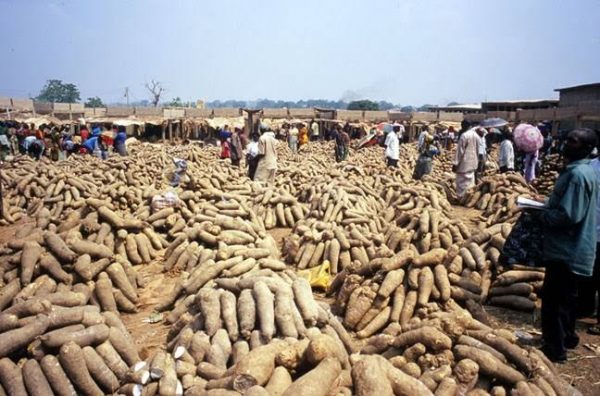Nigerian Soya Beans Export Potentials

Soya Beans Profile Trends
• Nigeria farmers through FMARD are making efforts at increasing production.
• Development of improved soybean varieties
• Soyabeans have an average protein content of 40%. It is more protein rich than any of the common vegetable or animal food sources found in Nigeria
• The Government supports the soyabean sector. Did you know?
➢ Nigeria’s soya beans sector has an advantage of being a country that only allows the farming of Non-genetically modified organisms (non-GMO) which have a niche demand in global market.
➢ In Nigeria the crop can be grown successfully even with the use of low agricultural inputs.
➢ Nigeria’s demand for soya bean will keep growing at a brisk pace. It is estimated that the domestic soybean requirement will grow to 3,000-3,500 TMT by 2040.
PRODUCTION
• Soyabeans were introduced to Nigeria in 1908; The first export was in 1947.
• Improving quality and increasing yields
• 17 Producing States.
• Smallholders and commercial farmers.
• The crop is well- suited for Nigeria
• Soybean crop farming is spread equally between north and middle belt region.
• Nigeria’s soyabeans production is rising steadily spurred by favourable grower prices and high demand.
NIGERIA SOYA BEANS PRODUCTION – METRIC TONNES NIGERIA PRODUCTION REGIONS High Medium High GLOBAL PRODUCING REGIONS
2.MARKETS
The market for soybean in Nigeria is growing very fast with opportunities for improving the income of farmers.
Currently, SALMA Oil Mills in Kano, Grand Cereals in Jos, ECWA Feeds in Jos, KARMA FOOD Ltd in Gwagwalada, AFCOT Oil Seed Processors, Ngurore, Adamawa State, and P.S. Mandrides in Kano, all process soybean. IITA and Olan grain have developed improved technologies for soybean production in Nigeria. Over the past few years, soybean production and consumption has expanded rapidly because of the growth in the industrial sector in oil production, animal feed production, and much more. The global conventional soybean market will experience a 5% CAGR from 2017 to 2025 reaching a total market value of USD 214.36 billion. This might potentially help balance the existing oversupply, should market conditions recover from COVID-related disruptions in the sector. The largest-soybean exporting countries in 2017, were Brazil, the United States and Argentina and the largest importing countries were China, Mexico and Netherlands. Furthermore, so much efforts should be made to increase soybean yields and there should be an increasing crop output to meet the growing needs of local feed millers and poultry farmers.
3. ACCESS TO MARKETS.
Soybean production and imports in Nigeria continue to rise as the country’s demand for the bean is expanding for both food and feed use. There is a growing shift by farmers in the country to increase soybean production levels with the help of international institute for tropical agriculture(IITA) and other international research institute. Each country has rules by the World Trade Organization (WTO) on how to trade in those countries. Certification makes the product to have a competitive edge in the global market, it will increase our market share, as well as profit.
The Covid-19 pandemic has made people to be more careful of what they consume. Obtaining these global certifications gives confidence to buyers and consumers, which underline their relevance in the international trade. Therefore, manufacturing and processing companies as well as the packaging companies operating in Nigeria are encouraged to put a well -structured framework in place to ensuring that their production processes and products are subject to both mandatory and non-mandatory Certification. However, there are some key factors for prospective export processors when dealing with buyers in export markets.
• Certification improves the processes of production, exporters need certification because of both the internal and external factors.
• Exporters must be able to provide certificates of quality that the product meets the quality specification and the laws of the importing country e.g., mycotoxin limits or maximum pesticide residue levels.
• Packaging should be the standard packaging agreed with the customer. Soya beans are usually packed in according to the buyer’s requirements. Soybeans are generally transported as bulk cargo but occasionally also as break-bulk cargo on bags of woven natural materials (pp bags) or woven plastic bags. Soyabean is packed manually in 50kg polypropylene bags with moisture content of 11%- 12% and temperature of 18%-24%
• Export contract is an agreement between the buyer and seller. It is important to assure your buyer that you are capable of executing the contract, thereby making sure you pay attention to details of the export contract agreed upon by both parties. As an exporter be familiar with government policy and regulations.
4. FINDING BUYERS
Soybeans could be exported and sold locally due to high demand for it. The soybeans must be cleaned in accordance with the storage regulations which is based on the temperature and moisture content. As the moisture levels increases. The watchwords for the potential export of soybeans are as follows:
✓ Which product? -bulk or consumption goods?
✓ Which market? do some research taking into account your advantages of location, quality and communication skills Europe and North America have high potential
✓ Which Channel? Will you sell through an Agent/Dealer, an Importer or direct to a buyer? If you are selling directly you will have to manage the buyer and to find new buyers. If you sell through an Agent/Dealer, it is more difficult to build a long term business Tip :- it is very important to understand the buyers needs well.. It is equally essential you meet the requirement of the market and buyer, hence to develop a successful export business a good understanding of your target market(s) is important
✓ Which customer? Research and get to know your prospective customer so that you can make good choices You can find buyers through seminars, export capacity building programmes, online research, trade associations, trade Fair exhibitor lists, workshops, conference attendees and many more. Once you find them make sure to communicate well and work on customer relationship management (CRM)
5. MANAGING SOYA BEANS EXPORT.
The Market situation has been responsible for volatility of the soybean. The variability in future and spot prices has caused problems not only for futures market participants, but also for consumers, the increasing risk has led to inefficient resource allocation for producers, merchandisers, and speculators, it also has the potential to limit access to food in developing countries that depend on imports and have lower incomes. The he volatility of soybeans futures prices is a concern for policy makers in order to assist them in decision making. National Bureau of Statistics the price has ranged from #15,000 per Ib FOB to #30,000 per Ib FOB from 2017-2020.
• Logistics and shipping documentation are important for buyers, before embarking on any export venture, please ensure you understand the basic term of delivery including pricing and documentation. Let the buyers know the required documents and make sure that the documents meet their needs and are practical from your point of view.
• Understand INCOTERMS 2020, this will enable you understand your responsibilities and that of the buyer. Engage efficient shipping services and make sure to keep your buyer advised every step of the way.
6. QUALITY ASSURANCE DOCUMENTS
This are key export documents which will help you to ensure that your exported goods conform to safety measures:
• Exporters registration certificate-NEPC
• Certification of quality and weight.
• Certificate of origin
• Phyto sanitary Certificate for agricultural commodities (issued by NAQS)
• Health certificate for processed food items issued by NAFDAC)
• Test certificate for harmful microbiological activity e.g., salmonella and aflatoxin.
• Test certificate showing product in conformity with maximum residue levels of the destination country.
7. SUPPORT AND REGULATION
The agricultural sector has no regulatory impediments to export. There is no export tax on soya beans and no import tax in high potential markets). NEPC can coordinate and harmonise export development and promotion activities such as providing exportable products list and simplifies export procedures.
8. SUCCESS STORIES
• In the crop year 2016-17, Olam was the largest buyer of Nigerian soybeans from local farmers and traders, Olam successfully created an export market for Nigerian soybeans and accounted for the bulk of soybean export.
• Surveys conducted by project researchers in the Oyo state region in Nigeria shows that in the last 5 years the number of people eating soybean has risen from near zero to 54%
• There are other success stories like ‘’soy milk’, soy ogi and soy iru, dawadawa. The milk made from soy flour can be prepared in the home in less than 15minutes. In the short term, children and nursing mothers have benefited greatly from the creation of protein-rich baby food like ‘’soyamusa’’ and “babeena” many hospitals and women’s group programs in Nigeria are promoting soybeans in their campaign to raise family and children’s nutrition levels.
• Soybean research and its implications for increased nutrition level among the Nigerian people has had a strong impact on the government.
The long- term goals of the soybean project in Nigeria are not only to increase nutrition in all sectors but to promote the beans in other African countries. Indeed, this project in Nigeria is having an impact in other countries as well. HS Codes Soya beans 1201100000
KEY POINTS
• Nigeria Soybean has a very high demand internationally.
• Soybean production is a very profitable-lucrative business that yields very fast returns.
• Nigeria can increase crop output to meet the growing needs.
• Minimise your export risk by conducting thorough market research which will help you understand the risks of doing business in a particular country then you can decide on how you want to control those risks.
• Ensure you meet buyer’s requirement by providing evidence of origin and delivery.
• Price volatility makes good management essential. Some Links https://www.olamgroup.com/locations/africa/nigeria.html https://www.iisd.org/system/files/publication soyinfocenter.com https://www.tridge.com http://nepc.gov.ng Different variety and versality of Soybean products sssoybeasoybeanprproduct Prepared by NEPC using the following sources UN Comm Trade. UNFAO. Ingredient Sourcing Solutions. EUStat. Institute of tropical agriculture(IITA) Institute of Agricultural Research and Training (IAR&T)
NOTE- NEPC can support your Export Business:NIGERIAN EXPORT PROMOTION COUNCIL Plot 424, Aguiyi Ironsi Street, Maitama, Abuja, Nigeria P. M. B. 133 Garki, Abuja ceo@nepc.gov.ng enquiries@nepc.gov.ng helpdesk@nepc.gov.ng






